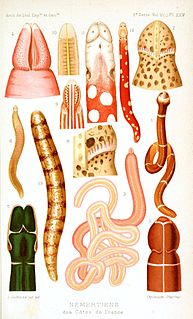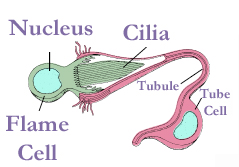
Bryozoa are a phylum of aquatic invertebrate animals. Typically about 0.5 millimetres long, they are filter feeders that sieve food particles out of the water using a retractable lophophore, a "crown" of tentacles lined with cilia. Most marine species live in tropical waters, but a few occur in oceanic trenches, and others are found in polar waters. One class lives only in a variety of freshwater environments, and a few members of a mostly marine class prefer brackish water. 5869 living species are known. One genus is solitary and the rest are colonial.

Cnidaria is a phylum under kingdom Animalia containing over 11,000 species of aquatic animals found both in freshwater and marine environments, predominantly the latter.

Nemertea is a phylum of invertebrate animals also known as ribbon worms or proboscis worms. Alternative names for the phylum have included Nemertini, Nemertinea and Rhynchocoela. Most are very slim, usually only a few millimeters wide, although a few have relatively short but wide bodies. Many have patterns of yellow, orange, red and green coloration. The foregut, stomach and intestine run a little below the midline of the body, the anus is at the tip of the tail, and the mouth is under the front. A little above the gut is the rhynchocoel, a cavity which mostly runs above the midline and ends a little short of the rear of the body. All species have a proboscis which lies in the rhynchocoel when inactive but everts to emerge just above the mouth and capture the animal's prey with venom. A highly extensible muscle in the back of the rhynchocoel pulls the proboscis in when an attack ends. A few species with stubby bodies filter feed and have suckers at the front and back ends, with which they attach to a host.
Seisonidae is a family of rotifers, found on the gills of Nebalia, a marine crustacean. Peculiar among rotifers, males and females are both present and equal in size. Males and females are similar with paired gonads. It is considered to have diverged from the other rotifers early on, and in one treatment is placed in a separate class Seisonoidea. They have a large and elongate body with reduced corona. Their muscular system is similar to that of other rotifers: They have longitudinal muscles as well as open annular muscles

Entoprocta, whose name means "anus inside", or Kamptozoa, is a phylum of mostly sessile aquatic animals, ranging from 0.1 to 7 millimetres long. Mature individuals are goblet-shaped, on relatively long stalks. They have a "crown" of solid tentacles whose cilia generate water currents that draw food particles towards the mouth, and both the mouth and anus lie inside the "crown". The superficially similar Bryozoa (Ectoprocta) have the anus outside a "crown" of hollow tentacles. Most families of entoprocts are colonial, and all but 2 of the 150 species are marine. A few solitary species can move slowly.

A flame cell is a specialized excretory cell found in the simplest freshwater invertebrates, including flatworms, rotifers and nemerteans; these are the simplest animals to have a dedicated excretory system. Flame cells function like a kidney, removing waste materials. Bundles of flame cells are called protonephridia.
In biology, a tagma is a specialized grouping of multiple segments or metameres into a coherently functional morphological unit. Familiar examples are the head, the thorax, and the abdomen of insects. The segments within a tagma may be either fused or so jointed as to be independently moveable.

Phaeacius is a spider genus of the family Salticidae, found in sub-tropical China and between India and the Malay Peninsula, including Sri Lanka, Sumatra and the Philippines. Although other spiders can jump, salticids including Phaeacius have significantly better vision than other spiders, and their main eyes are more acute in daylight than a cat's and 10 times more acute than a dragonfly's. The main eyes focus accurately on an object at distances from approximately 2 centimetres (0.79 in) to infinity, and in practice can see up to about 75 centimetres (30 in). They do not spin webs.

The Serpulidae are a family of sessile, tube-building annelid worms in the class Polychaeta. The members of this family differ from other sabellid tube worms in that they have a specialized operculum that blocks the entrance of their tubes when they withdraw into the tubes. In addition, serpulids secrete tubes of calcium carbonate. Serpulids are the most important biomineralizers among annelids. About 300 species in the family Serpulidae are known, all but one of which live in saline waters. The earliest serpulids are known from the Permian.

In animal anatomy, the mouth, also known as the oral cavity, buccal cavity, or in Latin cavum oris, is the opening through which many animals take in food and issue vocal sounds. It is also the cavity lying at the upper end of the alimentary canal, bounded on the outside by the lips and inside by the pharynx and containing in higher vertebrates the tongue and teeth. This cavity is also known as the buccal cavity, from the Latin bucca ("cheek").
In anatomy, a suture is a fairly rigid joint between two or more hard elements of an organism, with or without significant overlap of the elements.

Phoronids are a small phylum of marine animals that filter-feed with a lophophore, and build upright tubes of chitin to support and protect their soft bodies. They live in most of the oceans and seas, including the Arctic Ocean but excluding the Antarctic Ocean, and between the intertidal zone and about 400 meters down. Most adult phoronids are 2 cm long and about 1.5 mm wide, although the largest are 50 cm long.

Phylactolaemata is a class of the phylum Bryozoa whose members live only in freshwater environments. Like all bryozoans, they filter feed by means of an extensible "crown" of ciliated tentacles called a lophophore. They live in colonies, each of which consists of clones of the founding member. Unlike those of some marine bryozoans, phylactolaemate colonies consist of only one type of zooid, the feeding forms known as autozooids. These are supported by an unmineralized "exoskeleton" made of gelatinous material or protein, secreted by the zooids.
A follicle is a small spherical or vase-like group of cells enclosing a cavity in which some other structure grows or other material is contained. Thyroid follicles make up the thyroid gland. Follicles are best known as the sockets from which hairs grow in humans and other mammals, but the bristles of annelid worms also grow from such sockets.
In zoology, the epidermis is an epithelium that covers the body of a eumetazoan. Eumetazoa have a cavity lined with a similar epithelium, the gastrodermis, which forms a boundary with the epidermis at the mouth.

Cydippida is an order of comb jellies. They are distinguished from other comb jellies by their spherical or oval bodies, and the fact their tentacles are branched, and can be retracted into pouches on either side of the pharynx.
Portia africana is a jumping spider found in Angola, Cameroon, the Central African Republic, Gabon, Ghana, the Ivory Coast, Sierra Leone, Zaire and Zambia. Its conspicuous main eyes provide vision more acute than a cat's during the day and 10 times more acute than a dragonfly's, and this is essential in P. africana′s navigation, hunting and mating.

Statoblasts are a means to reproduce asexually by a method that is unique among bryozoans and enables a colony's lineage to survive the variable and uncertain conditions of freshwater environments. Statoblasts are masses of cells that function as "survival pods" rather like the gemmules of sponges. Statoblasts form on the funiculus (cord) connected to the parent's gut, which nourishes them. As they grow, statoblasts develop protective bivalve-like shells made of chitin. When they mature, some types stick to the parent colony, some fall to the bottom, some contain air spaces that enable them to float, and some remain in the parent's cystid to re-build the colony if it dies. Statoblasts can remain dormant for considerable periods, and while dormant can survive harsh conditions such as freezing and desiccation. They can be transported across long distances by animals, floating vegetation, currents and winds. When conditions improve, the valves of the shell separate and the cells inside develop into a zooid that tries to form a new colony. A study estimated that one group of colonies in a patch 1 square meter (11 sq ft) produced 800,000 statoblasts.
Discinida is an order of brachiopods comprising the extant superfamily Discinoidea, and the extinct superfamilies Botsfordioidea (early—mid-Cambrian) and Acrotheloidea. It represents a sister taxon to the Lingulids, and is possibly paraphyletic with respect to the Acrotretoids.—or the acrotretids are paraphyletic with respect to it. The group displays a broad range of shell structures, some of which incorporate substantial organic or silicified components.

The annelids, also known as the ringed worms or segmented worms, are a large phylum, with over 22,000 extant species including ragworms, earthworms, and leeches. The species exist in and have adapted to various ecologies – some in marine environments as distinct as tidal zones and hydrothermal vents, others in fresh water, and yet others in moist terrestrial environments.














